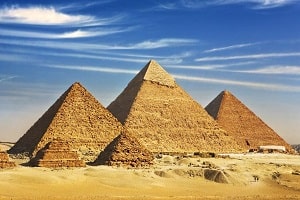Last Updated on 10/08/2023
See the shape of a pyramid looming in the desert, and one country alone comes to mind: Egypt. These magnificent structures are synonymous with Egyptian culture and history, and remain one of the main reasons why thousands upon thousands of tourists flock to the North African country each year.

Pyramids of Giza
By far the most recognizable pyramids within Egypt are the Pyramids of Giza, which sit (as one would expect) on the Giza Plateau (sometimes referred to as the Giza Necropolis; Necropolis meaning city of the dead) just outside of Cairo. In fact, the modern city of Cairo encroaches on the Plateau itself, bringing to mind an odd mix of the old and the new fusing together to make one thrilling tourist experience.
There are other pyramids to be visited in Egypt, though they are less prolific and require more travel from Cairo itself to see. The convenience is one of the main drawing points for the Giza pyramids, as well as their magnificence and their unrivaled size.
The foremost pyramid on the Plateau is known as The Great Pyramid of Giza and is one of the most recognizable landmarks in the world, as well as being one of the only remaining structures still standing that made up the famed Seven Wonders of the Ancient World.
What is a Pyramid?
For millennia, no one was entirely sure what the purpose of a pyramid was; they simply seemed to be amazing structures displaying an engineering might no one had credited an ancient civilization of possessing. However, with the onset of the study sector now referred to as Egyptology in the 19th century, over time the purpose of the pyramids has become apparent.
A pyramid is a tomb, erected in its distinctive shape as ancient Egyptians believed this would ensure the easiest passing to the afterlife for the deceased soul. Pyramids were primarily a reserve of the Egyptian Pharaohs, the monarchy of the time, particularly those from the older dynasties that make up the Old Kingdom. The New Kingdom Pharaohs tended to be buried more secretively at the Valley of the Kings. This change in custom makes most pyramids at least 3,500 years old.
Khufu, Pyramid King
The Great Pyramid was the burial site for Khufu, a Fourth dynasty Pharaoh who had an otherwise uneventful career on the throne. It was his father, Sneferu, who began what is referred to as the Pyramid Age; when pyramids were the chosen burial tombs for the royal line. Khufu perfected his father’s early work, and ordered construction to begin on the Great Pyramid almost as soon as he took the throne.
It is estimated the Great Pyramid alone took around 25 years to build, and was a huge industry for Egypt at the time, employing around two-thirds of the population in some way during its construction. Khufu was duly entombed in the pyramid following his death, but little remains of his burial chamber today; it was plundered by thieves in ancient times, one of the key reasons why pyramids went out of fashion and hidden tombs, such as those at the Valley of the Kings, came into general use.
Visiting the Giza Pyramids
Most hotels in Cairo will offer tourist trips to the Giza Plateau, and this is probably the best way of visiting the site; a guide will help you appreciate the historical significance of the pyramids to their greatest advantage. You can also pre-book tours online, though it is possible to just visit the easy to find (it’s well signposted) ticket office just outside of the Plateau if you’d rather just go it alone.
It is important to remember that the pyramids were not designed as tourist attractions, and are therefore not particularly visitor-friendly. If any member of your party has disability needs or claustrophobia, they are unlikely to be able to actually enter the pyramids themselves; the tunnels inside as small, requiring a lot of crouching and shuffling along the floor, so be prepared for this.
However, you do not have to go into the tunnels themselves; simply exploring the Giza Plateau itself can be a thrilling and rewarding experience.


 Call
Call WhatsApp
WhatsApp Enquiry
Enquiry